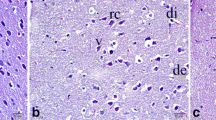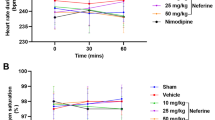Abstract
Neuroprotective effect of lipoxin A4 methyl ester (LXA4 ME) was tested in a rat model of permanent middle cerebral artery occlusion. LXA4 ME was administrated through intracerebroventricular injection immediately after middle cerebral artery was occluded. Administration of LXA4 ME ameliorated neurological deficit, reduced infarct volume, attenuated histological damage, and decreased number of apoptotic neuron induced by ischemic insult. These neuroprotective effects of LXA4 ME were associated with inhibition of neutrophil infiltration, lipid peroxidation, and astrocyte activation. In addition, LXA4 ME also attenuated proinflammatory cytokines (TNF-α and IL-1β) production. These data suggest that LXA4 ME protects neuron against permanent cerebral ischemia by inhibiting inflammatory responses.






Similar content being viewed by others
References
Bannenberg G, Moussignac RL, Gronert K et al (2004) Lipoxins and novel 15-epi-lipoxin analogs display potent anti-inflammatory actions after oral administration. Br J Pharmacol 143(1):43–52
Chiang N, Fierro IM, Gronert K, Serhan CN (2000) Activation of lipoxin A(4) receptors by aspirin-triggered lipoxins and select peptides evokes ligand-specific responses in inflammation. J Exp Med 191(7):1197–1208
Chiang N, Arita M, Serhan CN (2005) Anti-inflammatory circultry: lipoxin, aspirin- triggered lipoxins and their receptor ALX. Prostaglandins Leukot Essent Fat Acids 73(3–4):163–177
Dong Y, Benveniste EN (2001) Immune function of astrocytes. Glia 36(2):180–190
ElKebir D, József L, Filep JG (2008) Opposing regulation of neutrophil apoptosis through the formyl peptide receptor-like 1/lipoxin A4 receptor: implications for resolution of inflammation. J Leukoc Biol 84(3):600–606
Fierro IM, Colgan SP, Bernasconi G et al (2003) Lipoxin A4 and aspirin-triggered 15-epi-lipoxin A4 inhibit human neutrophil migration: comparisons between synthetic 15 epimers in chemotaxis and transmigration with microvessel endothelial cells and epithelial cells. J Immunol 170(5):2688–2694
Huang J, Upadhyay UM, Tamargo RJ (2006) Inflammation in stroke and focal cerebral ischemia. Surg Neurol 66(3):232–245
Jin SW, Zhang L, Lian QQ et al (2007) Posttreatment with aspirin-triggered lipoxin A4 analog attenuates lipopolysaccharide-induced acute lung injury in mice: the role of heme oxygenase-1. Anesth Analg 104(2):369–377
Jordán J, Segura T, Brea D et al (2008) Inflammation as therapeutic objective in stroke. Curr Pharm Des 14(33):3549–3564
Kim HJ, Rowe M, Ren M, Hong JS, Chen PS, Chuang DM (2007) Histone deacetylase inhibitors exhibit anti-inflammatory and neuroprotective effects in a rat permanent ischemic model of stroke: multiple mechanisms of action. J Pharmacol Exp Ther 321(3):892–901
Kleinig TJ, Vink R (2009) Suppression of inflammation in ischemic and hemorrhagic stroke: therapeutic options. Curr Opin Neurol 22(3):294–301
Lavine SD, Hofman FM, Zlokovic BV (1998) Circulating antibody against tumor necrosis factor-alpha protects rat brain from reperfusion injury. J Cereb Blood Flow Metab 18(1):52–58
Lawrence T, Willoughby DA, Gilroy DW (2002) Anti-inflammatory lipid mediators and insights into the resolution of inflammation. Nat Rev Immunol 2(10):787–795
Li JS, Zhang W, Kang ZM et al (2009) Hyperbaric oxygen preconditioning reduces ischemia-reperfusion injury by inhibition of apoptosis via mitochondrial pathway in rat brain. Neuroscience 159(4):1309–1315
Maddox JF, Hachicha M, Takano T, Petasis NA, Fokin W, Serhan CN (1997) Lipoxin A4 stable analogues are potent mimetics that stimulate human monocytes and THP-1 cell via a G-protein linked lipoxin A4 receptor. J Biol Chem 272(11):6972–6978
Medeiros R, Rodrigues GB, Figueiredo CP et al (2008) Molecular mechanisms of topical anti-inflammatory effects of lipoxin A(4) in endotoxin-induced uveitis. Mol Pharmacol 74(1):154–161
Mitchell S, Thomas G, Harvey K et al (2002) Lipoxins, aspirin-triggered epi-lipoxins, lipoxin stable analogues, and the resolution of inflammation: stimulation of macrophage phagocytosis of apoptotic neutrophils in vivo. J Am Soc Nephrol 13(10):2497–2507
Nascimento-Silva V, Arruda MA, Barja-Fidalgo C, Fierro IM (2007) Aspirin-triggered lipoxin A4 blocks reactive oxygen species generation in endothelial cells: a novel antioxidative mechanism. Thromb Haemost 97(1):88–98
Parkinson JF (2006) Lipoxin and synthetic lipoxin analogs: an overview of anti-inflammatory functions and new concepts in immunomodulation. Inflamm Allergy Drug Targets 5(2):91–106
Planagumà A, Kazani S, Marigowda G et al (2008) Airway lipoxin A4 generation and lipoxin A4 receptor expression are decreased in severe asthma. Am J Respir Crit Care Med 178(6):574–582
Pouliot M, Serhan CN (1999) Lipoxin A4 and aspirin-triggered 15-epi-LXA4 inhibit tumor necrosis factor-alpha-initiated neutrophil responses and trafficking: novel regulators of a cytokine-chemokine axis relevant to periodontal diseases. J Periodontal Res 34(7):370–373
Shang Y, Li X, Prasad PV et al (2009a) Erythropoietin attenuates lung injury in lipopolysaccharide treated rats. J Surg Res 155(1):104–110
Shang Y, Jiang YX, Xu SP et al (2009b) Reduction of pulmonary inflammatory response by erythropoietin in a rat model of endotoxaemia. Chin Med J (Engl) 122(7):834–838
Serhan CN, Savill J (2005) Resolution of inflammation: the beginning programs the end. Nat Immunol 6(12):1191–1197
Serhan CN, Maddox JF, Petasis NA et al (1995) Design of lipoxin A4 stable analogs that block transmigration and adhesion of human neutrophils. Biochemistry 34(44):14609–14615
Serhan CN, Chiang N, Van Dyke TE (2008) Resolving inflammation: dual anti-inflammatory and pro-resolution lipid mediators. Nat Rev Immunol 8(5):349–361
Sobrado M, Pereira MP, Ballesteros I et al (2009) Synthesis of lipoxin A4 by 5-lipoxygenase mediates PPARgamma-dependent, neuroprotective effects of rosiglitazone in experimental stroke. J Neurosci 29(12):3875–3884
Sodin-Semrl S, Spagnolo A, Mikus R, Barbaro B, Varga J, Fiore S (2004) Opposing regulation of interleukin-8 and NF-kappaB responses by lipoxin A4 and serum amyloid A via the common lipoxin A receptor. Int J Immunopathol Pharmacol 17(2):145–156
Souza DG, Fagundes CT, Amaral FA et al (2007) The required role of endogenously produced lipoxin A4 and annexin-1 for the production of IL-10 and inflammatory hyporesponsiveness in mice. J Immunol 179(12):8533–8543
Svensson CI, Zattoni M, Serhan CN (2007) Lipoxins and aspirin-triggered lipoxin inhibit inflammatory pain processing. J Exp Med 204(2):245–252
Wada K, Arita M, Nakajima A et al (2006) Leukotriene B4 and lipoxin A4 are regulatory signals for neural stem cell proliferation and differentiation. FASEB J 20(11):1785–1792
Wang CX, Shuaib A (2002) Involvement of inflammatory cytokines in central nervous system injury. Prog Neurobiol 67(2):161–172
Wang Q, Tang XN, Yenari MA (2007) The inflammatory response in stroke. J Neuroimmunol 184(1–2):53–68
Wu SH, Wu XH, Liao PY, Dong L (2007) Signal transduction involved in protective effects of 15(R/S)-methyl-lipoxin A(4) on mesangioproliferative nephritis in rats. Prostaglandins Leukot Essent Fat Acids 76(3):173–180
Xing B, Chen H, Zhang M et al (2008) Ischemic post-conditioning protects brain and reduces inflammation in a rat model of focal cerebral ischemia/reperfusion. J Neurochem 105(5):1737–1745
Yang GY, Zhao YJ, Davidson BL, Betz AL (1997) Overexpression of interleukin-1 receptor antagonist in the mouse brain reduces ischemic brain injury. Brain Res 751(12):181–188
Zhao L, Wang Y, Sun N, Liu X, Li L, Shi J (2007) Electroacupuncture regulates TRPM7 expression through the trkA/PI3K pathway after cerebral ischemia-reperfusion in rats. Life Sci 81(15):1211–1222
Zheng Z, Yenari MA (2004) Post-ischemic inflammation: molecular mechanisms and therapeutic implications. Neurol Res 26(8):884–892
Zhou XY, Wu P, Zhang L et al (2007) Effects of lipoxin A(4) on lipopolysaccharide induced proliferation and reactive oxygen species production in RAW264.7 macrophages through modulation of G-CSF secretion. Inflamm Res 56(8):324–333
Acknowledgments
This work was supported by the Grant from National Natural Science Foundation of China (No. 30700784).
Author information
Authors and Affiliations
Corresponding authors
Additional information
Yan Wu and Xi-Hong Ye contributed equally to this work.
Rights and permissions
About this article
Cite this article
Wu, Y., Ye, XH., Guo, PP. et al. Neuroprotective Effect of Lipoxin A4 Methyl Ester in a Rat Model of Permanent Focal Cerebral Ischemia. J Mol Neurosci 42, 226–234 (2010). https://doi.org/10.1007/s12031-010-9355-8
Received:
Accepted:
Published:
Issue Date:
DOI: https://doi.org/10.1007/s12031-010-9355-8




